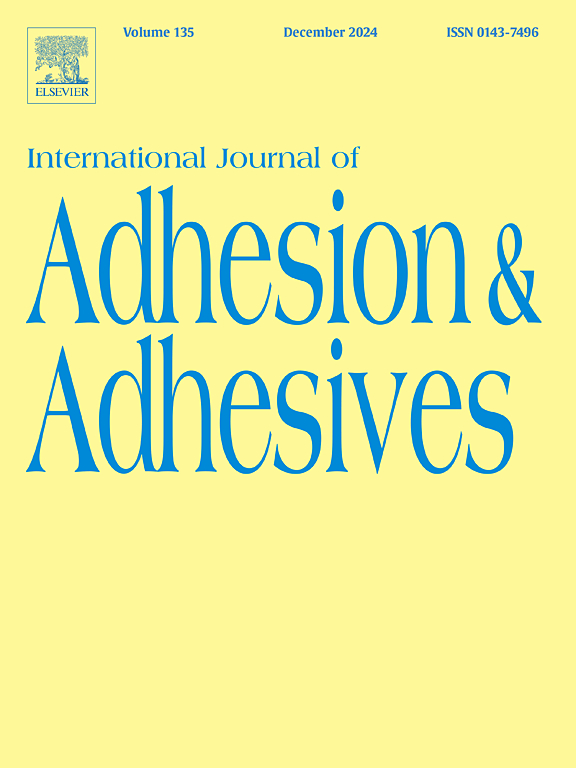Investigation on the mechanical properties of Nano-Al2O3 particle reinforced single lap adhesive joints using digimat mean field homogenization and finite element method
IF 3.2
3区 材料科学
Q2 ENGINEERING, CHEMICAL
International Journal of Adhesion and Adhesives
Pub Date : 2025-02-06
DOI:10.1016/j.ijadhadh.2025.103959
引用次数: 0
Abstract
When the studies on particle reinforced adhesive joints are evaluated, there is a deficiency in simulation methods. Considering the diversity of particles and the variability of reinforcement ratios, obtaining the mechanical properties of particle reinforced adhesives experimentally is a costly process with a high workload. In this study, the mechanical properties of single-lap adhesive joints (SLJs) produced with pure DP460 and 4 % nano-Al2O3 reinforced DP460 epoxy composite adhesive were investigated using Digimat Mean Field Homogenization and Finite Element Method (FEM). At first, bulk and SLJs specimens were produced from composite and pure adhesives to perform experimental studies. Next, based on the experimental studies, finite element analysis (FEA) of the bulk specimens and SLJs was conducted. In the FEM, the Digimat-Mean Field (Digimat-MF) homogenization approach and Ansys structural analysis were employed together. In the first step of the simulation studies, the mechanical properties of the nano-composite adhesive were obtained using the Digimat-MF homeogenization method. In the second step, Digimat interface was created in the Ansys program and material properties were defined. In this way, the structural analysis of nano-Al2O3 reinforced bulk specimens and SLJs were accurately analyzed. In the FEA, tensile strength values of bulk specimens of pure DP460 and 4 % nano-Al2O3 reinforced DP460 epoxy adhesives were obtained. At the end of the study, experimental and simulation data were verified and compared. When the data acquired were evaluated, it was seen that the Digimat-MF homogenization approach and Ansys FEM were successfully applied to adhesive joints containing composite adhesives.
采用数字平均场均匀化和有限元法研究纳米al2o3颗粒增强单搭接接头的力学性能
在评价颗粒增强粘接研究时,模拟方法存在不足。考虑到颗粒的多样性和配筋率的可变性,实验获得颗粒增强胶粘剂的力学性能是一个成本高、工作量大的过程。采用Digimat平均场均匀化和有限元法研究了纯DP460和4%纳米al2o3增强DP460环氧复合胶粘剂制备的单搭接接头(slj)的力学性能。首先,用复合胶粘剂和纯胶粘剂制作体块和slj试样进行实验研究。其次,在试验研究的基础上,对体试件和slj进行有限元分析。在有限元分析中,采用了数字平均场(Digimat-MF)均匀化方法和Ansys结构分析相结合的方法。在模拟研究的第一步,采用Digimat-MF均匀化方法获得纳米复合胶粘剂的力学性能。第二步,在Ansys程序中创建Digimat界面,定义材料属性。通过这种方法,可以准确地分析纳米al2o3增强体试样和slj的结构分析。在有限元分析中,获得了纯DP460和4%纳米al2o3增强DP460环氧胶粘剂的体块试样的拉伸强度值。在研究的最后,对实验数据和仿真数据进行了验证和比较。对采集到的数据进行评估后,可以看到Digimat-MF均质化方法和Ansys FEM成功地应用于含复合胶粘剂的粘接接头。
本文章由计算机程序翻译,如有差异,请以英文原文为准。
求助全文
约1分钟内获得全文
求助全文
来源期刊

International Journal of Adhesion and Adhesives
工程技术-材料科学:综合
CiteScore
6.90
自引率
8.80%
发文量
200
审稿时长
8.3 months
期刊介绍:
The International Journal of Adhesion and Adhesives draws together the many aspects of the science and technology of adhesive materials, from fundamental research and development work to industrial applications. Subject areas covered include: interfacial interactions, surface chemistry, methods of testing, accumulation of test data on physical and mechanical properties, environmental effects, new adhesive materials, sealants, design of bonded joints, and manufacturing technology.
 求助内容:
求助内容: 应助结果提醒方式:
应助结果提醒方式:


